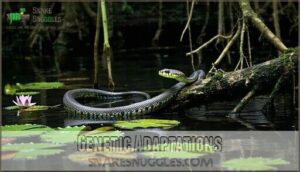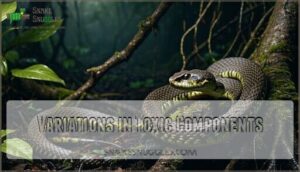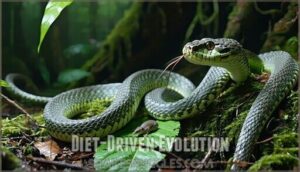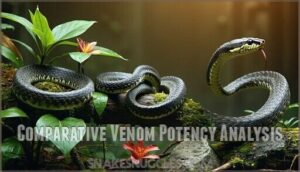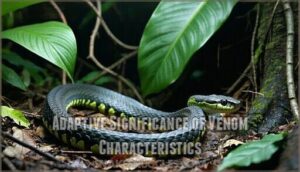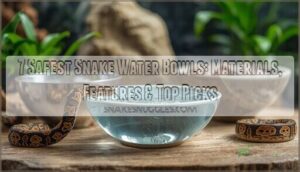This site is supported by our readers. We may earn a commission, at no cost to you, if you purchase through links.

You’ll find these pit vipers constantly tweaking their venom recipes based on what they’re hunting and where they’re living.
Their genetic toolkit produces different toxin cocktails – some species pack more hemorrhagins for bleeding prey out, while others load up on neurotoxins for quick kills.
It’s like having a Swiss Army knife that reshapes itself depending on the job.
Diet drives much of this evolution: snakes hunting birds develop faster-acting venoms than those targeting mammals.
Geographic isolation creates distinct venom profiles even within the same species.
This molecular arms race between predator and prey continues shaping these remarkable biochemical weapons across generations, with each species adapting to its environment in a unique way, making them a fascinating example of nature’s deadly chemistry lab in action, and showcasing their ability to develop different toxin cocktails.
Table Of Contents
- Key Takeaways
- Evolution of Fer-de-Lance Toxin
- Venom Composition Changes
- Environmental Influences on Toxin Development
- Comparative Venom Potency Analysis
- Adaptive Significance of Venom Characteristics
- Frequently Asked Questions (FAQs)
- What toxins are in fer-de-lance?
- What happens if a fer-de-lance bites you?
- Is the Bothrops asper poisonous?
- What are the adaptations of the fer-de-lance snake?
- How poisonous is a fer-de-lance?
- What is the antidote for fer-de-lance?
- What is the survival rate for a fer-de-lance bite?
- How aggressive is a fer-de-lance?
- What are my chances?
- What should I do if bitten?
- Conclusion
Key Takeaways
- You’ll discover fer-de-lance venom isn’t static—it’s constantly evolving through genetic adaptations that create specialized toxin cocktails tailored to specific prey and environmental pressures.
- Your understanding of these snakes’ deadly chemistry reveals how diet drives venom evolution, with bird-hunting species developing faster-acting neurotoxins while mammal hunters focus on hemorrhagic compounds.
- You’ll find geographic isolation creates distinct venom profiles even within the same species, demonstrating how environmental factors trigger unique genetic variations and toxin compositions.
- You’re witnessing nature’s molecular arms race in action, where fer-de-lance toxins evolve faster than prey can adapt, creating remarkably efficient biochemical weapons that guarantee hunting success.
Evolution of Fer-de-Lance Toxin
You’ll discover that fer-de-lance toxin evolution represents nature’s sophisticated molecular biology experiment.
These snakes have developed venom genetics that continuously adapt through evolutionary toxinology processes, creating highly specialized weapons.
Nature’s molecular arms race produces venoms that evolve faster than prey can adapt.
Snake toxin evolution demonstrates remarkable ecological adaptation as these vipers face changing environments.
Their fer de lance venom contains zinc-dependent metalloproteinases, phospholipases A2, and serine proteinases that’ve undergone accelerated genetic changes.
This venom toxin evolution process involves gene duplication events that produce diverse toxic components.
You’re witnessing toxin resistance mechanisms that drive continuous adaptation.
Snake behavior patterns influence how these venoms develop, with genetic drift and gene flow shaping evolutionary pathways.
The selection pressure creates unique venom profiles across different fer-de-lance species.
Environmental factors trigger genetic variations within species, leading to diverse venom compositions.
This toxin evolution enhances adaptability, allowing snakes to fine-tune their biochemical arsenal.
The interplay between genetic factors and environmental influences results in remarkable adaptation mechanisms that guarantee survival across varied habitats.
Venom Composition Changes
You’ll discover that fer-de-lance venom isn’t fixed in stone—it’s constantly changing through genetic adaptations that fine-tune its deadly cocktail.
These snakes pack their venom with an evolving mix of metalloproteinases, phospholipases, and other toxic components that vary dramatically between species and even within the same population, making their venom a highly variable asset.
Genetic Adaptations
You’ll find that genetic adaptations drive fer-de-lance toxin evolution through fascinating molecular mechanisms.
Gene duplication creates raw material for evolutionary tradeoffs, allowing venom proteins to diversify without losing essential functions. Molecular evolution accelerates in toxin genes, especially on microchromosomes, where rapid changes fine-tune venom potency.
Selection pressure shapes toxin gene expression, creating toxicity variance between populations. Genetic drift and gene flow work together, producing unique venom profiles that reflect each snake’s evolutionary history.
This adaptive genetics process creates the remarkable diversity you see in fer-de-lance venoms today, with evolutionary biology revealing how these snakes balance lethality with metabolic costs through snake toxin evolution.
The study of venom spitting behavior is essential in understanding the complex interactions between these snakes and their environments.
Variations in Toxic Components
Throughout evolution, you’ll notice fer-de-lance venom displays remarkable toxin diversity driven by molecular adaptation.
Individual snakes show significant venom variance in component complexity, particularly affecting phospholipase A2 and metalloproteinase levels.
The venom composition is influenced by the snake’s pit viper characteristics and adaptations to their environment.
- Toxic Evolution Patterns: Venom composition varies dramatically between individual snakes, with fibrinogen-clotting and enzyme profiles showing distinct differences that reflect each snake’s unique evolutionary pressures and environmental adaptations.
Environmental Influences on Toxin Development
You’ll find that where fer-de-lance snakes live and what they hunt directly shapes their venom chemistry.
Environmental pressures like prey availability and habitat threats drive evolutionary changes that fine-tune toxin potency for maximum hunting success.
Habitat Impact
Geographic variation drives fer de lance venom adaptation across diverse terrains.
You’ll discover that diverse terrains sculpt each fer-de-lance’s unique venom chemistry through relentless environmental pressures.
You’ll find habitat diversity creates unique ecological pressures that shape toxin profiles.
Environmental factors like altitude, humidity, and prey availability trigger genetic adaptations in venom composition.
Terrain effects influence environmental adaptation, with forest-dwelling snakes developing different venom toxicity levels than those in agricultural areas, demonstrating nature’s precision in habitat-specific evolution.
The study of habitat toxin levels is essential in understanding the complex relationships between snakes and their environments, as seen in habitat toxin research.
Diet-Driven Evolution
Fer de lance venom showcases remarkable dietary adaptations that optimize hunting success.
Prey selection drives toxin specialization, with genetic adaptations creating venom components customized to specific prey types. You’ll find these snakes developing different toxin profiles based on their ecological niche requirements.
- Prey-Specific Toxins: Fer de lance venom contains specialized components targeting different prey categories, from small mammals to birds, with toxin resistance patterns reflecting local prey adaptations.
- Metabolic Optimization: Dietary adaptations influence venom production costs, with snakes developing more efficient toxin delivery systems for their primary food sources.
- Adaptive Advantages: Venom optimization provides evolutionary benefits through improved prey immobilization rates and reduced energy expenditure during hunting sequences.
Comparative Venom Potency Analysis
When you compare fer-de-lance venom potency across different species and time periods, you’ll find striking differences that reflect their evolutionary adaptations.
These variations in toxicity levels reveal how each species has fine-tuned its venom composition to match specific hunting needs and environmental pressures, showcasing striking differences.
Toxicity Levels Over Time
While venom composition shows remarkable stability, fer-de-lance toxicity levels reveal fascinating temporal variations that you’d find surprising.
Research demonstrates that venom potency remains consistent over decades, even after long-term storage. However, evolution patterns show age-dependent shifts in toxin trends, with juvenile snakes producing more potent neurotoxic components than adults.
These toxicity shifts reflect ongoing venom evolution driven by prey specialization. Studies on fer de lance specimens confirm that venomous snake bites maintain their lethal potential regardless of the snake’s age in captivity, indicating genetic stability in venom toxicity across time.
The analysis of venom potency is essential for understanding the venom potency test results in various species.
Inter-Species Variances
Among fer-de-lance species, you’ll find striking interspecies variances in venom toxicity and composition.
Phylogenetic analysis reveals how evolutionary paths diverged, creating distinct toxic variance patterns.
Species comparison shows Bothrops atrox produces hemorrhagic effects while B. lanceolatus causes thrombotic complications.
Genetic diversity drives these differences, with snake venom peptides and metalloproteinases varying substantially between populations, demonstrating how genetic variations shape deadly outcomes.
The study of snake venom types is essential in understanding these complex variations in venom composition and toxicity.
Adaptive Significance of Venom Characteristics
You’ll discover that fer de lance venom efficiency represents nature’s perfect hunting toolkit through toxic adaptation.
Snake ecology reveals how evolutionary pressures drive molecular diversity in venom composition. Genetic adaptations enable venom peptide synthesis suited to specific prey types and environmental challenges.
This adaptive nature guarantees rapid paralysis and death of targets, guaranteeing hunting success.
Venom toxicology studies show how habitat variations influence toxin potency, with each species developing specialized compounds for their ecological niche, making these serpents remarkably effective predators.
The unique ability of snakes to develop venom immunity mechanisms plays a vital role in their survival and hunting strategies.
Frequently Asked Questions (FAQs)
What toxins are in fer-de-lance?
Each year, 100,000 people die from snakebites worldwide.
You’ll encounter zinc-dependent metalloproteinases, phospholipases A2, serine proteinases, vasoactive peptides, disintegrins, L-amino acid oxidases, cysteine-rich secretory proteins, and C-type lectin-like components in fer-de-lance venom.
What happens if a fer-de-lance bites you?
A fer-de-lance bite triggers immediate pain and swelling at the wound site.
You’ll experience tissue death, bleeding problems, and potential shock.
Without quick antivenom treatment, you’re facing serious complications or death.
Is the Bothrops asper poisonous?
Worldwide, snakebites kill 100,000 people annually. Yes, Bothrops asper is venomous, not poisonous – it injects toxins through fangs rather than being toxic when eaten, causing severe hemorrhaging and tissue damage.
What are the adaptations of the fer-de-lance snake?
You’ll find fer-de-lance snakes have evolved remarkable adaptations for survival.
Their venom composition changes based on geography, diet, and genetics, creating specialized toxin cocktails that efficiently paralyze prey while adapting to local environments.
How poisonous is a fer-de-lance?
Consider a hiker in Costa Rica who’s bitten by a fer-de-lance – you’re facing one of the world’s most dangerous venomous snakes.
Its venom contains potent metalloproteinases and phospholipases causing severe tissue damage, hemorrhaging, and potentially fatal coagulopathies requiring immediate antivenom treatment.
What is the antidote for fer-de-lance?
You’ll need antivenom immediately – it’s the only effective treatment for fer-de-lance bites. Specific antivenoms like Bothrofav neutralize the venom’s deadly effects when administered promptly at medical facilities.
What is the survival rate for a fer-de-lance bite?
Time becomes your enemy when fer-de-lance venom courses through your bloodstream.
You’ll face approximately 50-60% survival rates without immediate antivenom treatment, but prompt medical intervention dramatically improves your chances to over 95% survival.
How aggressive is a fer-de-lance?
Fer-de-lance snakes are notoriously aggressive and unpredictable, making them extremely dangerous to humans. You’ll find they strike without warning when threatened, earning their fearsome reputation throughout Central and South America.
What are my chances?
Your survival odds depend on immediate medical access and antivenom availability.
With prompt treatment, survival rates exceed 95%.
Without antivenom within hours, mortality jumps to 20-30% due to coagulopathies and systemic complications.
What should I do if bitten?
Seek emergency medical care immediately – don’t wait for symptoms to develop.
Call paramedics, remain calm, and keep the bite below heart level.
Antivenom treatment within hours dramatically improves your survival chances and prevents severe complications, which is why it is crucial to act quickly to receive antivenom.
Conclusion
Through nature’s relentless laboratory, fer-de-lance toxin evolution continues rewriting the rules of survival.
You’ve witnessed how these serpents craft specialized venom cocktails, fine-tuning their biochemical weapons through countless generations.
Environmental pressures and dietary preferences sculpt each species’ toxic arsenal, creating remarkable diversity in potency and composition.
This ongoing molecular arms race demonstrates evolution’s precision, as fer-de-lance toxin evolution adapts to ecological demands with deadly efficiency.
- https://en.wikipedia.org/wiki/Bothrops_asper
- https://journals.plos.org/plosntds/article?id=10.1371%2Fjournal.pntd.0011083
- https://pubmed.ncbi.nlm.nih.gov/33972420/
- https://www.sciencedaily.com/releases/2022/06/220606134426.htm
- https://www.pnas.org/post/journal-club/snake-venom-evolved-in-fits-and-spurts

